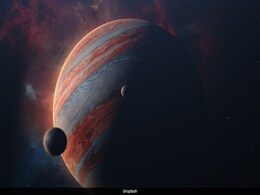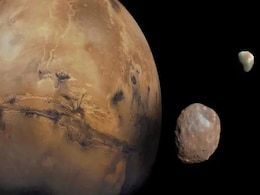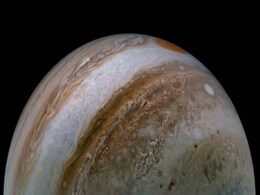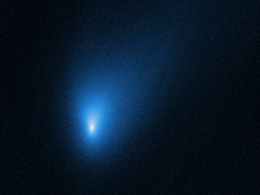Solar System And Gravity
- All
- News
- Videos
-

Jupiter Was Once Twice Its Size - And Its Magnetic Field Could Fry Spacecraft
- Thursday May 22, 2025
- Science | Edited by Nikhil Pandey
Jupiter's early evolution and gravitational influence played a crucial role in shaping the solar system's structure and planetary orbits, earning it the title of the solar system's "architect."
-
 www.ndtv.com
www.ndtv.com
-

Asteroid Vesta May Be a Fragment of a Lost Planet, Say Scientists
- Friday May 9, 2025
- Written by Gadgets 360 Staff
Vesta, once believed to be a stalled protoplanet, may be a fragment of a long-lost differentiated planet. Using refined gravity data from NASA’s Dawn mission, scientists found it lacks a dense core, suggesting it was ejected during a primordial impact. This revised view may apply to other asteroids and reshape planetary formation theories.
-
 www.gadgets360.com
www.gadgets360.com
-

Over 1 Million Interstellar Objects Could Be Hidden in Our Solar System
- Tuesday February 18, 2025
- Written by Gadgets 360 Staff
A new study reveals that more than 1 million interstellar objects, each larger than the Statue of Liberty, may be residing in the Oort Cloud. These objects, believed to have originated from the Alpha Centauri system, were captured by the Sun’s gravity and are now part of our solar system. Unlike fast-moving interstellar visitors, these objects re...
-
 www.gadgets360.com
www.gadgets360.com
-

Super-Earth In the Solar System Could Have Rendered Our Planet Uninhabitable, Says Study
- Wednesday November 27, 2024
- Written by Gadgets 360 Staff
A recent study explores a hypothetical super-Earth between Mars and Jupiter, revealing its severe impact on Earth's orbit and climate. Conducted by Florida Institute of Technology scientists Emily Simpson and Howard Chen, the simulation demonstrates how such a planet’s gravity could destabilise neighbouring planets, causing erratic orbits and ext...
-
 www.gadgets360.com
www.gadgets360.com
-

Mars' Moons Might Have Been Created From Asteroids Coming Too Close to the Red Planet
- Wednesday November 27, 2024
- Written by Gadgets 360 Staff
A study published in Icarus explores the possibility that Mars’ moons, Phobos and Deimos, formed from asteroid debris torn apart by the planet’s gravitational forces. Researchers ran advanced simulations to propose this scenario, which fits the moons’ circular orbits better than previous theories. Japan’s upcoming MMX mission is expected to...
-
 www.gadgets360.com
www.gadgets360.com
-

NASA Europa Clipper Advances Toward Jupiter’s Moon, Instruments Successfully Deployed
- Tuesday November 26, 2024
- Written by Gadgets 360 Staff
NASA’s Europa Clipper spacecraft, launched in October 2024, is journeying toward Jupiter’s moon Europa to study its icy surface and hidden ocean. Currently over 13 million miles from Earth, the spacecraft has successfully deployed its solar arrays, magnetometer boom, and radar antennas. It will use a gravity assist from Mars in March 2025 to ad...
-
 www.gadgets360.com
www.gadgets360.com
-

Juno's Study Provides Insight on Jupiter's Composition, Gravitational Field
- Monday June 13, 2022
- Edited by Gadgets 360 Newsdesk
A new study has researched about Jupiter's metal concentration and distribution, suggesting that the planet ate a lot of rocky planetesimals when it was young. The authors sought to use Juno's Gravity Science experiment to investigate the metals in the planet's atmosphere. Jupiter's atmosphere isn't as homogeneous as originally imagined, according ...
-
 www.gadgets360.com
www.gadgets360.com
-

BepiColombo Space Probe Makes First Venus Fly-by on Way to Mercury
- Thursday October 15, 2020
- Associated Press
A spacecraft bound for Mercury swung by Venus on Thursday, using Earth's neighbour to adjust its course on the way to the solar system’s smallest and innermost planet. .
-
 www.gadgets360.com
www.gadgets360.com
-

Mercury-Bound Spacecraft Swings by Earth, Beams Back Pictures
- Saturday April 11, 2020
- Associated Press
A Mercury-bound spacecraft swooped past Earth on Friday, tweaking its roundabout path to the solar system’s smallest and innermost planet.
-
 www.gadgets360.com
www.gadgets360.com
-

An Alien Comet From Another Star Is Soaring Through Our Solar System
- Friday November 29, 2019
- Sarah Kaplan, The Washington Post
Something strange is sailing toward us. This is an interstellar comet - an ancient ball of ice and gas and dust, formed on the frozen outskirts of a distant star, which some lucky quirk of gravity has tossed into our path.
-
 www.gadgets360.com
www.gadgets360.com
-

Small And Fast, Strange Alien Comet From Another Star In Solar System
- Friday November 29, 2019
- Science | Sarah Kaplan, The Washington Post
Something strange is sailing toward us. Something small and cold and extraordinarily fast. No one knows where it came from, or where it is going. But it's not from around here. This is an interstellar comet - an ancient ball of ice and gas and dust, formed on the frozen outskirts of a distant star, which some lucky quirk of gravity has tossed into ...
-
 www.ndtv.com
www.ndtv.com
-
Comet may be visible from Earth if it survives sun's heat, gravity
- Thursday November 28, 2013
- World News | Reuters
A comet that left the outer edge of the solar system more than 5.5 million years ago will pass close by the sun on Thursday, becoming visible in Earth's skies in the next week or two - if it survives.
-
 www.ndtv.com
www.ndtv.com
-

Jupiter Was Once Twice Its Size - And Its Magnetic Field Could Fry Spacecraft
- Thursday May 22, 2025
- Science | Edited by Nikhil Pandey
Jupiter's early evolution and gravitational influence played a crucial role in shaping the solar system's structure and planetary orbits, earning it the title of the solar system's "architect."
-
 www.ndtv.com
www.ndtv.com
-

Asteroid Vesta May Be a Fragment of a Lost Planet, Say Scientists
- Friday May 9, 2025
- Written by Gadgets 360 Staff
Vesta, once believed to be a stalled protoplanet, may be a fragment of a long-lost differentiated planet. Using refined gravity data from NASA’s Dawn mission, scientists found it lacks a dense core, suggesting it was ejected during a primordial impact. This revised view may apply to other asteroids and reshape planetary formation theories.
-
 www.gadgets360.com
www.gadgets360.com
-

Over 1 Million Interstellar Objects Could Be Hidden in Our Solar System
- Tuesday February 18, 2025
- Written by Gadgets 360 Staff
A new study reveals that more than 1 million interstellar objects, each larger than the Statue of Liberty, may be residing in the Oort Cloud. These objects, believed to have originated from the Alpha Centauri system, were captured by the Sun’s gravity and are now part of our solar system. Unlike fast-moving interstellar visitors, these objects re...
-
 www.gadgets360.com
www.gadgets360.com
-

Super-Earth In the Solar System Could Have Rendered Our Planet Uninhabitable, Says Study
- Wednesday November 27, 2024
- Written by Gadgets 360 Staff
A recent study explores a hypothetical super-Earth between Mars and Jupiter, revealing its severe impact on Earth's orbit and climate. Conducted by Florida Institute of Technology scientists Emily Simpson and Howard Chen, the simulation demonstrates how such a planet’s gravity could destabilise neighbouring planets, causing erratic orbits and ext...
-
 www.gadgets360.com
www.gadgets360.com
-

Mars' Moons Might Have Been Created From Asteroids Coming Too Close to the Red Planet
- Wednesday November 27, 2024
- Written by Gadgets 360 Staff
A study published in Icarus explores the possibility that Mars’ moons, Phobos and Deimos, formed from asteroid debris torn apart by the planet’s gravitational forces. Researchers ran advanced simulations to propose this scenario, which fits the moons’ circular orbits better than previous theories. Japan’s upcoming MMX mission is expected to...
-
 www.gadgets360.com
www.gadgets360.com
-

NASA Europa Clipper Advances Toward Jupiter’s Moon, Instruments Successfully Deployed
- Tuesday November 26, 2024
- Written by Gadgets 360 Staff
NASA’s Europa Clipper spacecraft, launched in October 2024, is journeying toward Jupiter’s moon Europa to study its icy surface and hidden ocean. Currently over 13 million miles from Earth, the spacecraft has successfully deployed its solar arrays, magnetometer boom, and radar antennas. It will use a gravity assist from Mars in March 2025 to ad...
-
 www.gadgets360.com
www.gadgets360.com
-

Juno's Study Provides Insight on Jupiter's Composition, Gravitational Field
- Monday June 13, 2022
- Edited by Gadgets 360 Newsdesk
A new study has researched about Jupiter's metal concentration and distribution, suggesting that the planet ate a lot of rocky planetesimals when it was young. The authors sought to use Juno's Gravity Science experiment to investigate the metals in the planet's atmosphere. Jupiter's atmosphere isn't as homogeneous as originally imagined, according ...
-
 www.gadgets360.com
www.gadgets360.com
-

BepiColombo Space Probe Makes First Venus Fly-by on Way to Mercury
- Thursday October 15, 2020
- Associated Press
A spacecraft bound for Mercury swung by Venus on Thursday, using Earth's neighbour to adjust its course on the way to the solar system’s smallest and innermost planet. .
-
 www.gadgets360.com
www.gadgets360.com
-

Mercury-Bound Spacecraft Swings by Earth, Beams Back Pictures
- Saturday April 11, 2020
- Associated Press
A Mercury-bound spacecraft swooped past Earth on Friday, tweaking its roundabout path to the solar system’s smallest and innermost planet.
-
 www.gadgets360.com
www.gadgets360.com
-

An Alien Comet From Another Star Is Soaring Through Our Solar System
- Friday November 29, 2019
- Sarah Kaplan, The Washington Post
Something strange is sailing toward us. This is an interstellar comet - an ancient ball of ice and gas and dust, formed on the frozen outskirts of a distant star, which some lucky quirk of gravity has tossed into our path.
-
 www.gadgets360.com
www.gadgets360.com
-

Small And Fast, Strange Alien Comet From Another Star In Solar System
- Friday November 29, 2019
- Science | Sarah Kaplan, The Washington Post
Something strange is sailing toward us. Something small and cold and extraordinarily fast. No one knows where it came from, or where it is going. But it's not from around here. This is an interstellar comet - an ancient ball of ice and gas and dust, formed on the frozen outskirts of a distant star, which some lucky quirk of gravity has tossed into ...
-
 www.ndtv.com
www.ndtv.com
-
Comet may be visible from Earth if it survives sun's heat, gravity
- Thursday November 28, 2013
- World News | Reuters
A comet that left the outer edge of the solar system more than 5.5 million years ago will pass close by the sun on Thursday, becoming visible in Earth's skies in the next week or two - if it survives.
-
 www.ndtv.com
www.ndtv.com













